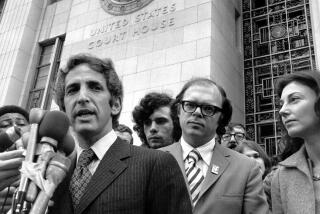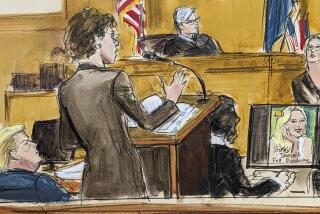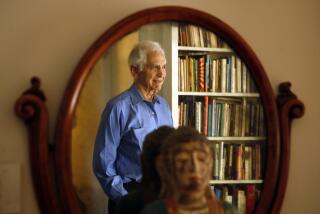Westmoreland Trial Focuses on Struggle Between Two Men
NEW YORK â There were moments when he seemed haughty and cocksure, and there were times when he groped unsteadily to remember details.
But in nearly six days of tedious examination before a federal jury, former CIA analyst Sam Adams stuck doggedly to the story he has pushed for more than a decade--that Gen. William C. Westmoreland was in the middle of a conspiracy that misled President Lyndon B. Johnson and Congress on the size of the enemy threat at a crucial moment in the long Vietnam War.
When the assertion was made in a CBS television documentary in 1982, it led to Westmorelandâs $120-million libel suit against the network and to a much-publicized trial, now in its 15th week.
During Adamsâ exhaustive testimony as the lead-off witness for the defense, the network faded into the background and the court fight came into focus as a personal struggle between two men--the 70-year-old retired general and Adams, who was once the CIAâs bookkeeper on the Viet Cong.
Each regards the lawsuit as a test of his professional integrity and his personal honor. The jury is essentially being asked to decide, based on a mounting stack of technical, arcane and contradictory testimony, whom to believe.
For Adams, two days of cross-examination by Westmorelandâs lawyers was a mine field.
Chief Source of Story
He had been a participant in events covered by the controversial documentary, âThe Uncounted Enemy: A Vietnam Deception.â He had been the chief source for the programâs story line. He had been deeply involved in its reporting, and he had been on the CBS payroll as a paid consultant.
Over the years, he had testified before a congressional committee investigating the controversy underlying the program. He had been a witness in Daniel Ellsbergâs espionage trial, growing out of the revelation of classified Pentagon papers, and he had begun the manuscript of a book.
When he was still at the CIA, Adams had become so consumed by the issue of enemy strength that he had carried secret documents to his Virginia farm and buried them in garbage bags, and had sent others to Rep. Paul N. McCloskey (R-Calif.), who became one of Congressâ most outspoken critics of the war.
All of this, plus the fact that he had tried unsuccessfully to get Westmoreland investigated by the inspector general of the Army, left Adams vulnerable not only to cross-examination on all the minor details he has related over the years, but to accusations that he was carrying on a vendetta against the general who commanded U.S. troops in Vietnam from 1964 until 1968.
But instead of attacking Adams on grounds that he was carrying on a personal feud against Westmoreland, the generalâs lawyers examined in microscopic detail his accounts of how the estimates were produced.
They introduced one Adams statement suggesting that he believed that Gen. Earle G. Wheeler, the Army chief of staff, was party to the purposeful understatement of enemy strength.
Reminded of Doubts
They reminded him of statements he made during the Ellsberg case, in which he had emphasized the difficulty of deciding which enemy irregular troops should be counted and seemingly expressed some of the same doubts cited by Westmoreland in defense of the Armyâs excluding irregular self-defense forces from estimates of enemy strength.
In the end, Westmorelandâs lawyers suggested that at the time of the broadcast, Adams had serious reservations about the program and was not comfortable with the flat-out assertion that Westmoreland was part of a conspiracy to underestimate the enemy so the progress of the war would look better in Washington.
Says General Issued Order
They also suggested that since he left the CIA, Adams has found it a profitable career to write about, talk about and investigate âthe uncounted enemy,â an assertion that made Adams flush with anger on the witness stand.
Through it all, Adams insisted that he believed at the time of the broadcast and continues to believe now that Westmoreland conspired to cut down the enemy troop estimates made by his commandâs intelligence experts.
Questioned by CBS attorney David Boies after Westmorelandâs attorneys had completed their cross-examination, Adams insisted that Westmoreland had personally ordered the numbers of enemy irregulars cut after he received a briefing in May, 1967.
Adams said Col. Gains Hawkins, then Westmorelandâs aide responsible for estimating enemy troop strength, had told him âGen. Westmoreland found the higher totals to be unacceptable . . . and directed that such totals be reduced.â
By August, 1967, Adams testified, Hawkinsâ estimate of irregulars of various types had been scaled down in the total presented by Westmorelandâs command.
Hawkinsâ estimate of 100,000 guerrillas had been cut to 65,000, Adams told the jury, the 140,000 estimate for political cadres had been cut to 80,000 to 85,000, and the number of service troops had been downgraded from 75,000 to somewhere between 17,000 and 35,000.
Enemy Strength Ceiling
Repeatedly throughout his testimony, Adams insisted that Westmoreland had imposed a ceiling of 300,000 on enemy strength, and that aides cut and juggled their count of various categories to stay under that amount.
CBS and Adams, who is a co-defendent, contend that Col. Daniel Graham and other unnamed officers under Westmorelandâs command met at the Pentagon during August, 1967, when U.S. intelligence was putting together an updated national intelligence estimate, and arbitrarily slashed enemy strength, eliminating units and reducing the size of others with the stroke of a pencil.
In one of the major conflicts of testimony, Graham, who later rose to lieutenant general and headed the Defense Intelligence Agency, swore he was not even in the United States when the meeting took place.
CBS attorneys sought to show through Adamsâ testimony that the network held no malice against Westmoreland in its conclusions.
Visited Memorial
In one of the most dramatic moments in the trial since Westmorelandâs wife wept during his testimony, Adams described a visit to the Vietnam Veterans Memorial in Washington, telling the jury of scanning the thousands of names engraved in the stone face and wondering how many of the men had been killed by enemy troops stricken from Westmorelandâs enemy strength estimate.
But even then, there was no show of emotion from Westmoreland.
Throughout Adamsâ testimony, he and the silver-haired general often looked each other straight in the eye. They spoke cordially whenever they met in the courtroom.
And as CBS prepared to bring on the CIA and Army witnesses it interviewed in the documentary, Adams told the jury he still believed that Westmoreland might have acted under pressure from his superiors in causing enemy strength estimates to be reduced.
He had, he said, come to feel sorry for nearly everybody involved in the episode.
After the CBS attorneys finished with Adams this week, they moved to buttress his account by calling George Allen, a longtime Vietnam expert and Adamsâ immediate boss at the CIA.
Allen told the jury that in early 1967 there was a consensus in the intelligence community that the enemy troop estimates of the U.S. command were too low. Allen called the enemy self-defense militia, which Westmoreland opposed counting, âan integral part of the military force,â which accounted for as many as 40% of the U.S. casualties.
Allen was glowing in his praise of Adams, saying his work at the CIA displayed a âdegree of integrity commensurate with the CIA motto, âYe shall know the truth and the truth shall make ye free.â â
More to Read
Sign up for Essential California
The most important California stories and recommendations in your inbox every morning.
You may occasionally receive promotional content from the Los Angeles Times.










